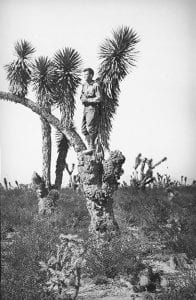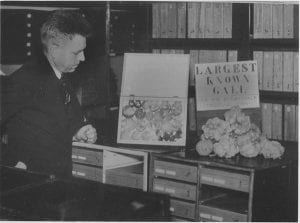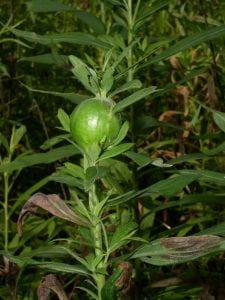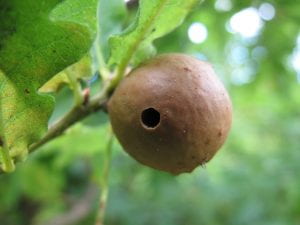
Kinsey and the Wasps: Mapping a Journey
Part Two, in Which We Meet the Mentor
In our first installment, we learned of the remarkable energy and precision—some would say fanaticism—Kinsey brought to his gall wasp research, along with the extraordinarily comprehensive nature of his specimen collection. We also touched on the marvelous mysteries of galls themselves, and the various insects, diseases, and other irritants that prompt plants to generate them.

This post offers a look at Kinsey’s meandering path to wasp obsession and the influence of William Morton Wheeler, the mentor that inspired and encouraged Kinsey’s early efforts. The copious notes and data that Kinsey amassed, culminating in his volume The Gall Wasp Genus Cynips (1930), are emblematic of his remarkably rigorous and comprehensive scholarship, which seem to have grown out of his mentor’s influence and Kinsey’s own proclivities in equal measure.

Not surprisingly, much of the writing on Kinsey’s life is centered on his groundbreaking sex research, which began in earnest after his thorough interrogation of gall wasps had wound down. However, a couple of the heftier biographies go into Kinsey’s early life and research in some depth (see References section below). It turns out that, although he eventually settled on them as a promising research topic, gall wasps were not Kinsey’s first choice: he dabbled in beetles for a time.1
Reading the chapter “Ah, I Perceive That You Are An Entomologist” in James H. Jones’s biography of Kinsey is more entertaining than one might guess from the title. This is in part because of Jones’s description of William Morton Wheeler, Kinsey’s main mentor at the Bussey Institute at Harvard. Students found him “aloof” and “hard to approach,”2 but he was a zoology rock star who enjoyed nights of raucous drinking—flouting Prohibition with the likes of H.L. Mencken. Wheeler was one of a growing number of life-sciences celebrities in in the early 20th century. Darwin’s work, and theories of evolution and natural selection in general, had become widely accepted, yet there was plenty of room in the field, with vast numbers of species still undiscovered, and many others whose origins remained a mystery. Young scholars like Kinsey could daydream about the tantalizing adventures to be had roaming the countryside, studying and even naming new species on the scientific frontier.

Though William Morton Wheeler was by all accounts fond of partying, he was deadly serious when it came to ant research. In Six Legs Better: A Cultural History of Myrmecology, Charlotte Sleigh describes Wheeler’s role as follows:
“During the hundred years covered here, ants metamorphosed through three main forms, appearing sequentially as psychological, sociological, and informational entities. In other words, they were used successively to model the human mind, society, and communication. For each period, one figure stands out from the scientific milieu. For the era of psychological modeling it is the Swiss psychiatrist Auguste Forel (1848–1931). For the sociological era it is the American academic and coiner of the term myrmecology, William Morton Wheeler (1865–1937), and for the information era it is the American sociobiologist Edward O. Wilson (1929–). These were the dominant interpreters in each era, the myrmecologists who established in each case the appropriate ‘scientific’ way to see the ant.”3
If you actually get to name your field? Rock star.
Kinsey loved the outdoors and had shown an early interest in biology. But prior to university study, he had not hit upon an obvious path forward, in large part because his father wanted other things for him. Wheeler, on the other hand, saw in Kinsey the makings of an excellent entomologist. The elder researcher set about mentoring his young student in earnest: honing his research skills, in the lab but especially in the field; encouraging his considerable gift for focused, detailed work; and advising him on how to achieve academic success, including fostering in Kinsey a lifelong commitment to achieving collections of unsurpassed quantity and detail.
William Morton Wheeler helped Kinsey become a formidable scientific mind and the world’s leading expert on gall wasps. In The Gall Wasp Genus Cynips, Kinsey describes 48 new species of gall wasps, one of which he named “cynips pezomachoides wheeleri.“4
In our next installment, we cover Kinsey at IU! Stay tuned.
Footnotes
1Jones, James H. Alfred C. Kinsey : a Public/Private Life. 1st ed. New York: W. W. Norton, 1997, p. 141.
2Ibid., p. 134.
3Sleigh, Charlotte. Six Legs Better: a Cultural History of Myrmecology. Baltimore: Johns Hopkins University Press, 2007, p. 11.
4Kinsey, Alfred C. The Gall Wasp Genus Cynips: a Study In the Origin of Species. Bloomington, Indiana: Indiana University Studies, 1930, p. 380.
References
Christenson, Cornelia V. Kinsey: a Biography. Bloomington: Indiana University Press, 1971.
Jones, James H. Alfred C. Kinsey: a Public/Private Life. 1st ed. New York: W.W. Norton, 1997.
Kinsey, Alfred C. The Gall Wasp Genus Cynips: a Study In the Origin of Species. Bloomington, Indiana: Indiana University Studies, 1930.
Sleigh, Charlotte. Six Legs Better: a Cultural History of Myrmecology. Baltimore: Johns Hopkins University Press, 2007.
“The Bussey Institute.” The Harvard Crimson. 28 January 1886, https://www.thecrimson.com/article/1886/1/28/the-bussey-institute-there-is-a/. Accessed February 4, 2020.
Heather Sloan is an ILS Master’s student with a specialization in Digital Humanities. She is a full-time staff member in the Media Services and Government Information, Maps & Microform Services (GIMMS) departments of Herman B Wells Library. She has a Doctor of Musical Arts degree in Percussion Performance from SUNY Stony Brook, and her interests include Caribbean folkloric music, Latin music, record collecting, and design in popular culture. Her Digital Humanities work focuses on intersections between digital and humanitarian mapping, the environment, and arts advocacy. She is a 2019-2020 HASTAC Scholar.





